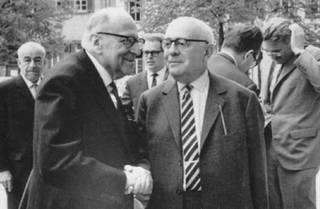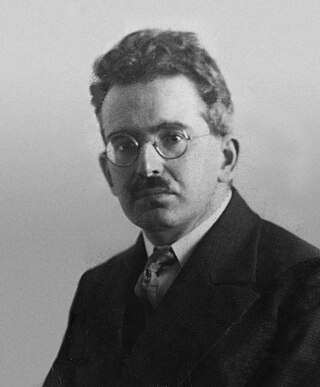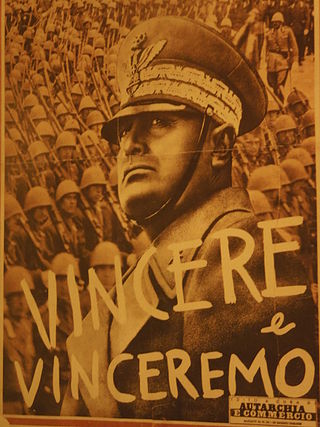
Fascism is a far-right, authoritarian, ultranationalist political ideology and movement, characterized by a dictatorial leader, centralized autocracy, militarism, forcible suppression of opposition, belief in a natural social hierarchy, subordination of individual interests for the perceived good of the nation or race, and strong regimentation of society and the economy.

The Frankfurt School is a school of thought in sociology and critical philosophy. It is associated with the Institute for Social Research founded at Goethe University Frankfurt in 1923. Formed during the Weimar Republic during the European interwar period, the first generation of the Frankfurt School was composed of intellectuals, academics, and political dissidents dissatisfied with the contemporary socio-economic systems of the 1930s; namely, capitalism, fascism, and communism.
Art for art's sake—the usual English rendering of l'art pour l'art, a French slogan from the latter half of the 19th century—is a phrase that expresses the philosophy that 'true' art is utterly independent of any and all social values and utilitarian function, be that didactic, moral, or political. Such works are sometimes described as autotelic, a concept that has been expanded to embrace "inner-directed" or "self-motivated" human beings.

Benedetto Croce, KOCI, COSML was an Italian idealist philosopher, historian, and politician who wrote on numerous topics, including philosophy, history, historiography, and aesthetics. A political liberal in most regards, he formulated a distinction between liberalism and "liberism". Croce had considerable influence on other Italian intellectuals, from Marxists to Italian fascists, such as Antonio Gramsci and Giovanni Gentile, respectively.
This is an alphabetical index of articles about aesthetics.

Richard Wolin is an American intellectual historian who writes on 20th Century European philosophy, particularly German philosopher Martin Heidegger and the group of thinkers known collectively as the Frankfurt School.

"The Work of Art in the Age of Mechanical Reproduction" (1935), by Walter Benjamin, is an essay of cultural criticism which proposes and explains that mechanical reproduction devalues the aura (uniqueness) of a work of art, and that in the age of mechanical reproduction and the absence of traditional and ritualistic value, the production of art would be inherently based upon the praxis of politics. Written during the Nazi régime (1933–1945) in Germany, in the essay Benjamin presents a theory of art that is "useful for the formulation of revolutionary demands in the politics of art" in a society of mass culture.

The history of fascist ideology is long and it draws on many sources. Fascists took inspiration from sources as ancient as the Spartans for their focus on racial purity and their emphasis on rule by an elite minority. Fascism has also been connected to the ideals of Plato, though there are key differences between the two. Fascism styled itself as the ideological successor to Rome, particularly the Roman Empire. From the same era, Georg Wilhelm Friedrich Hegel's view on the absolute authority of the state also strongly influenced fascist thinking. The French Revolution was a major influence insofar as the Nazis saw themselves as fighting back against many of the ideas which it brought to prominence, especially liberalism, liberal democracy and racial equality, whereas on the other hand, fascism drew heavily on the revolutionary ideal of nationalism. The prejudice of a "high and noble" Aryan culture as opposed to a "parasitic" Semitic culture was core to Nazi racial views, while other early forms of fascism concerned themselves with non-racialized conceptions of the nation.

Maurice Bardèche was a French art critic and journalist, better known as one of the leading exponents of neo-fascism in post–World War II Europe. Bardèche was also the brother-in-law of the collaborationist novelist, poet and journalist Robert Brasillach, executed after the liberation of France in 1945.

New Masses (1926–1948) was an American Marxist magazine closely associated with the Communist Party USA. It succeeded both The Masses (1912–1917) and The Liberator (1918–1924). New Masses was later merged into Masses & Mainstream (1948–1963). With the coming of the Great Depression in 1929 America became more receptive to ideas from the political Left and New Masses became highly influential in intellectual circles. The magazine has been called “the principal organ of the American cultural left from 1926 onwards."
The Communist Party of Iran (Marxist–Leninist–Maoist) is an Iranian communist party working for revolution to establish a new socialist republic in place of the Islamic Republic of Iran. The party takes as its political framework the new synthesis of communism, and is a descendant of the Maoist Sarbedaran.
What constitutes as a definition of fascism and fascist governments has been a complicated and highly disputed subject concerning the exact nature of fascism and its core tenets debated amongst historians, political scientists, and other scholars ever since Benito Mussolini first used the term in 1915. Historian Ian Kershaw once wrote that "trying to define 'fascism' is like trying to nail jelly to the wall".
Marxist aesthetics is a theory of aesthetics based on, or derived from, the theories of Karl Marx. It involves a dialectical and materialist, or dialectical materialist, approach to the application of Marxism to the cultural sphere, specifically areas related to taste such as art, beauty, and so forth. Marxists believe that economic and social conditions, and especially the class relations that derive from them, affect every aspect of an individual's life, from religious beliefs to legal systems to cultural frameworks. From one classic Marxist point of view, the role of art is not only to represent such conditions truthfully, but also to seek to improve them ; however, this is a contentious interpretation of the limited but significant writing by Marx and Engels on art and especially on aesthetics. For instance, Nikolay Chernyshevsky, who greatly influenced the art of the early Soviet Union, followed the secular humanism of Ludwig Feuerbach more than he followed Marx.
Palingenetic ultranationalism is a definition of "true fascism" proposed by political theorist Roger Griffin. The phrase was first coined by Griffin in his 1991 book The Nature of Fascism. A key element is the belief that fascism can be defined by what Griffin posits in his book to be the true core myth of fascism, namely that of the need for a social revolution to occur first before a "national rebirth", palingenesis, could then take place.
Articles in social and political philosophy include:

Fascist movements in Europe were the set of various fascist ideologies which were practiced by governments and political organizations in Europe during the 20th century. Fascism was born in Italy following World War I, and other fascist movements, influenced by Italian Fascism, subsequently emerged across Europe. Among the political doctrines which are identified as ideological origins of fascism in Europe are the combining of a traditional national unity and revolutionary anti-democratic rhetoric which was espoused by the integral nationalist Charles Maurras and the revolutionary syndicalist Georges Sorel.

The Aesthetic Dimension: Toward a Critique of Marxist Aesthetics is a 1977 book on aesthetics by the philosopher Herbert Marcuse, in which the author provides an account of modern art's political implications and relationship with society at large.

Reactionary modernism is a term first coined by Jeffrey Herf in the 1980s to describe the mixture of "great enthusiasm for modern technology with a rejection of the Enlightenment and the values and institutions of liberal democracy" that was characteristic of the German Conservative Revolutionary movement and Nazism. In turn, this ideology of reactionary modernism was closely linked to the original, positive view of the Sonderweg, which saw Germany as the great Central European power neither of the West nor of the East.
Proletarian nation was a term used by 20th century Italian nationalist intellectuals such as Enrico Corradini to refer to Italy and other nations that they regarded as having the characteristics, through analogy with the proletariat, of being productive, morally vigorous, and inclined to bold action. Corradini admired revolutionary proletarian movements such as syndicalism for their tactics, although he opposed their goals, and he wanted to inspire a radical nationalist movement that would use similar tactics in service of different goals: a movement that would advocate imperialist war in place of class revolution, while maintaining the same methods of "maximum cohesion, concentration of forces, iron discipline and utter ruthlessness." Corradini associated the concept of proletariat with the economic function of production, arguing that all producers are in a moral sense proletarian, and he believed that all producers should be at the forefront of a new imperialist proletarian nation.
Fascist syndicalism was an Italian trade syndicate movement that rose out of the pre-World War II provenance of the revolutionary syndicalist movement led mostly by Edmondo Rossoni, Sergio Panunzio, Angelo Oliviero Olivetti, Michele Bianchi, Alceste De Ambris, Paolo Orano, Massimo Rocca, and Guido Pighetti, under the influence of Georges Sorel, who was considered the "'metaphysician' of syndicalism". The fascist syndicalists differed from other forms of fascism in that they generally favored class struggle, worker-controlled factories and hostility to industrialists, which lead historians to portray them as "leftist fascist idealists" who "differed radically from right fascists." Generally considered one of the more radical fascist syndicalists in Italy, Rossoni was the "leading exponent of fascist syndicalism", and sought to infuse nationalism with "class struggle".










